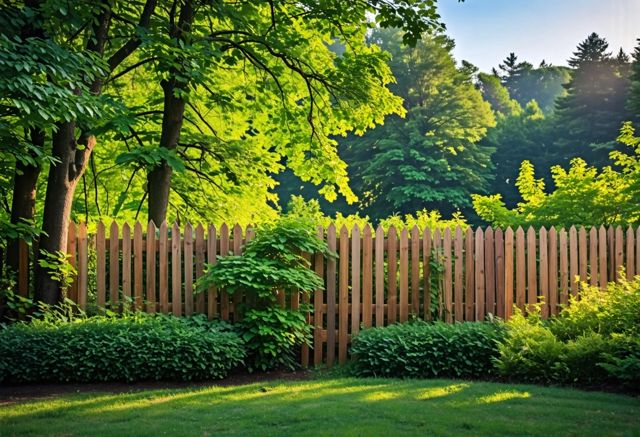Exotic hardwoods like Ipe, Teak, and Tigerwood are valued for their durability, beauty, and resistance to pests. These tropical woods provide long-lasting and striking fencing options with minimal maintenance.
What are Exotic Hardwoods?
Exotic hardwoods stand out for their remarkable durability, beauty, and sustainability, making them a favorite for fencing. These woods come from tropical regions and feature unique properties that contribute to their long-lasting nature and striking appearance.
Durability and Aesthetic Appeal
- Ipe: Known for its density and resistance to rot, decay, and pests. It boasts a rich chocolate-brown color that deepens over time.
- Teak: Prized for its natural oils and high silica content. Teak remains resistant to moisture and pests, aging from golden-brown to a silvery patina.
- Tigerwood: Recognized for its vibrant reddish-brown hues with dark streaks. It resists rot and decay well.
Common Types of Exotic Hardwoods
- Batu (Red Balau): Features a warm red to deep brown color with purple tinges. It has a moderately fine texture and interlocked grain.
- Cumaru: Known for its honey brown to reddish-brown shades. It’s dense, durable, and versatile, often referred to as Brazilian Teak or Brazilian Chestnut.
- Garapa: A hardy, dense wood that comes in golden-brown shades. It’s a budget-friendly alternative to Ipe.
Maintenance Tips
To keep exotic hardwood fences in top shape, consider:
- Regular Cleaning: Use gentle cleaners to prevent dirt and mildew build-up.
- Sealing: Apply a protective sealant every 1-2 years to guard against moisture and UV rays.
- Inspections and Repairs: Address issues like rot, pest infestation, and weather damage promptly. Learn more about expert tips for fencing installation.
Sustainability
Many exotic hardwoods come from well-managed forests. Certifications like the Forest Stewardship Council (FSC) ensure these woods are harvested responsibly. For example, Batu and Cumaru are sourced from sustainable forests in Indonesia and Brazil.
Exotic hardwoods provide a luxurious and long-lasting solution for fencing, combining natural beauty with robust performance and environmental responsibility.

Benefits of Using Exotic Hardwoods for Fencing
Using exotic hardwoods for fencing offers many advantages:
- Exceptional Durability:
- Lasts 50+ years with minimal maintenance.
- Less susceptible to rot, decay, and pests.
- Outstanding Aesthetics:
- Unique and vibrant colors.
- Striking grain patterns.
- Sustainability:
- Look for certifications like the Forest Stewardship Council (FSC).
- Ensuring responsible forestry practices.
Exotic hardwoods are also fire-resistant, adding safety, especially in areas prone to wildfires. They remain structurally sound over time, reducing the chances of boards breaking or coming loose.
Proper installation is crucial for maximizing the lifespan of exotic hardwood fences. This includes preparing the ground properly and using corrosion-resistant fasteners. Regular maintenance involves cleaning, sealing, and inspections to address any potential issues promptly.
Choosing exotic hardwoods for your fence combines beauty, durability, and sustainability. They require less frequent and easier maintenance compared to other types of wood, making them a superior choice for enhancing your outdoor spaces.
Popular Types of Exotic Hardwoods
Exotic woods, often called tropical hardwoods, come from tropical regions and are famous for their rich colors, unique grain patterns, and toughness. Here’s a helpful guide to some well-known types used in fencing:
- Purpleheart: From Central and South America, known for its purple color and resistance to decay and insects.
- Zebrawood: Native to West Africa, features dark brown stripes on a golden-yellow background.
- Rosewood: Found in Brazil, India, and Southeast Asia. Prized for its stability and intricate patterns.
- Teak: Strength and resistance to moisture and pests.
- Ebony: Originating from Africa and Asia, its jet-black color and smooth finish.
- Mahogany: Famous for its reddish-brown tones and stability.
- Bubinga: Also known as African Rosewood, notable for stability and resistance to decay.
- Wenge: From Central Africa, with dark streaks and straight grain.
- Cocobolo: Native to Central America, with vibrant colors and swirling grains.
- Bocote: Found in Central and South America, known for light to dark brown colors with black striping.
- Tigerwood: Orange to reddish-brown color with dark stripes, from South America.
- Padauk: From Africa and Asia, with vibrant orange to reddish-brown color deepening over time. Discover more in our guide to Padauk wood.
- African Blackwood: Known for its deep black color and density.
- Snakewood: From Central and South America, with distinctive “snakeskin” patterns.
- Lacewood: Native to South America, characterized by lace-like grain patterns.
Most Exotic Type of Wood:
- Pau Amarello (Brazilian Satinwood): Known for vibrant yellow to golden-brown color and striking figures.
Other notable exotic woods include Sandalwood, Lignum Vitae, Ziricote, and Amboyna Burl, each known for their rare beauty and distinctive grain patterns, often used in specialty projects and luxury items.

How to Choose the Right Exotic Hardwood for Your Property
Choosing the right exotic hardwood for your property can be challenging, but knowing the qualities of each wood can help. Exotic hardwoods are known for their beauty and durability. Here are some things to consider when selecting the best type for your project.
Types of Exotic Hardwoods
- Ipe (Brazilian Walnut):
- Dense and very strong
- Chocolate-brown color that deepens over time
- Resistant to rot and pests
- Requires regular cleaning and sealing
- Teak:
- Contains natural oils, providing moisture and pest resistance
- Golden-brown color that ages to a silvery patina
- High silica content, adding to its durability
- Tigerwood:
- Vibrant reddish-brown with dark streaks
- Visually striking
- Resistant to decay and insect damage
- Requires maintenance to maintain its look
- Garapa (Brazilian Ash):
- Hardy and dense
- Golden brown shades
- Budget-friendly alternative to Ipe
- Highly resistant to mold and rot
- Cumaru (Brazilian Teak):
- Medium to dark brown
- Lower cost compared to Ipe
- Resistant to decay and weathering
Sustainability
When selecting exotic hardwood, consider its environmental impact. Look for wood harvested from responsibly managed forests certified by the Forest Stewardship Council (FSC). This ensures biodiversity and environmental protection.
Regional Considerations
Climate and local conditions influence wood selection:
- Ipe and Redwood are popular in coastal USA due to moisture resistance.
- In Canada, Cedar and pressure-treated Pine are preferred for durability in extreme weather.
- Australia favors Merbau and Jarrah for heat and pest resilience.
Installation and Maintenance
Proper installation and maintenance extend the life of your exotic wood fence:
- Ensure adequate drainage and airflow
- Use corrosion-resistant fasteners
- Regularly seal the wood and clean to prevent rot and pest damage
Investing in exotic hardwood fencing can add value and beauty to your property. By choosing the right wood, ensuring sustainable sourcing, and maintaining it properly, you can enjoy a durable and stunning fence for years.

Maintenance Tips for Exotic Hardwood Fences
Caring for exotic hardwood fences is important to keep them looking their best and prolong their lifespan. Here are practical tips to maintain your exotic hardwood fence:
- Regular Cleaning: Clean your fence with mild soap and water. Use a soft brush to remove dirt and avoid abrasives that could damage the wood.
- Sealant Application: Apply a high-quality sealant to protect against moisture, UV rays, and insects. This helps maintain the wood’s natural color and prevents cracking.
- Annual Inspection: Check your fence every year for any signs of damage. Look for cracks, rot, or insect damage and treat any problems early.
- Staining: Use a stain that matches your wood type. Apply it in thin coats and let it dry completely between coats to enhance the wood’s appearance and protection. Learn more about how to stain your fence.
For more information about our services and products, visit Pickets.
Maintaining an exotic hardwood fence takes some effort, but these tips will ensure your fence remains beautiful and durable for years to come.

FAQ
What are exotic hardwoods?
Exotic hardwoods are durable, beautiful, and sustainable woods from tropical regions. They are known for their long-lasting nature and striking appearance, making them ideal for fencing.
Which exotic hardwoods are known for their durability and aesthetic appeal?
- Ipe: Dense and resistant to rot, decay, and pests. It has a rich chocolate-brown color that deepens over time.
- Teak: Contains natural oils and high silica content, making it resistant to moisture and pests. Ages from golden-brown to silvery patina.
- Tigerwood: Has vibrant reddish-brown hues with dark streaks. It is resistant to rot and decay.
What are some common types of exotic hardwoods used in fencing?
- Batu (Red Balau): Warm red to deep brown color with purple tinges and a moderately fine texture.
- Cumaru: Honey brown to reddish-brown shades, dense and versatile.
- Garapa: Golden-brown shades, dense, and is a budget-friendly option.
How can I maintain my exotic hardwood fence?
- Regular Cleaning: Use gentle cleaners to remove dirt and mildew.
- Sealing: Apply a protective sealant every 1-2 years to protect against moisture and UV rays.
- Inspections and Repairs: Regularly check for and address issues like rot, pest infestation, and weather damage.
Are exotic hardwoods sustainable?
Yes, many exotic hardwoods come from well-managed forests. Certifications like the Forest Stewardship Council (FSC) ensure these woods are harvested responsibly.
What are the benefits of using exotic hardwoods for fencing?
Exotic hardwoods offer durability, lasting over 50 years with minimal maintenance. They have outstanding aesthetics with unique colors and grain patterns. These woods are also sustainable, often coming from forests certified by the FSC.
What are some popular types of exotic hardwoods?
- Purpleheart: Known for its purple color and resistance to decay and insects.
- Zebrawood: Features dark brown stripes on a golden-yellow background.
- Rosewood: Prized for its stability and intricate patterns.
- Teak: Strong and resistant to moisture and pests.
- Ebony: Jet-black color and smooth finish.
- Mahogany: Famous for its reddish-brown tones and stability.
- Bubinga: Notable for stability and resistance to decay.
- Wenge: Popular for its dark streaks and straight grain.
- Cocobolo: Known for vibrant colors and swirling grains.
- Bocote: Light to dark brown colors with black striping.
- Tigerwood: Orange to reddish-brown color with dark stripes.
- Padauk: Vibrant orange to reddish-brown color.
- African Blackwood: Deep black color and dense.
- Snakewood: Distinctive “snakeskin” patterns.
- Lacewood: Characterized by lace-like grain patterns.
- Pau Amarello (Brazilian Satinwood): Vibrant yellow to golden-brown color.
How do I choose the right exotic hardwood for my property?
Consider the durability, aesthetic appeal, and environmental impact of each hardwood. Look for sustainable sources and certifications like the FSC. Factor in regional conditions, proper installation, and maintenance requirements to select the best wood for your needs.

